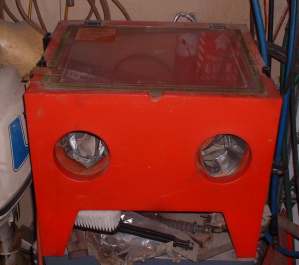
¶ Lots of times we run across motorcycle parts that have been, shall we say neglected? Parts that are badly corroded. To clean these parts we need more then than a tooth brush and some solvent. We need to really blast those parts clean.
A Sand Blaster takes the blasting media of your choice, blows it through a gun shaped nozzle and onto the part you want cleaned. This gun uses the venturi principle and compressed air to suck the blast media, through a tube, up into the gun and out the nozzle. A trigger on the gun controls the blast of air.
While there are lots of different grits and sizes and combinations of media it really boils down to this. There are basically, three types of blasting media.
- Walnut Shell
- Glass Beads
- Sand
Walnut Shell at 60x |
Glass Beads at 60x |
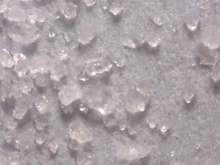 Sand at 60x |
 If you have a part that is not too badly corroded or a part off a bike you are restoring that must not be damaged, walnut is a good media to clean up that part. Walnut will clean the part without removing any metal or changing the surface of the part. Walnut does a good job if the part is just dirty. I had a piece of duct tape separating the blasted and unblasted surfaces. Notice that the part is just cleaned and the surface of the metal is not changed. There is not much difference between the cleaned and uncleaned surfaces except that the surface is clean.
If you have a part that is not too badly corroded or a part off a bike you are restoring that must not be damaged, walnut is a good media to clean up that part. Walnut will clean the part without removing any metal or changing the surface of the part. Walnut does a good job if the part is just dirty. I had a piece of duct tape separating the blasted and unblasted surfaces. Notice that the part is just cleaned and the surface of the metal is not changed. There is not much difference between the cleaned and uncleaned surfaces except that the surface is clean.
 The next grade up is glass beads. Glass beads are, well, beads of glass! They are round and will not take off much if any metal. They do sort of harden the surface of the metal. This makes glass beads especially good for cleaning internal engine parts. Not only do you clean the part but the bombardment of the metal with the glass beads actually hardens the surface of the metal. Glass beads are easier to clean off the parts too. Notice the surface looks like you hit it with a million strokes from the worlds smallest ball-peen hammer.
The next grade up is glass beads. Glass beads are, well, beads of glass! They are round and will not take off much if any metal. They do sort of harden the surface of the metal. This makes glass beads especially good for cleaning internal engine parts. Not only do you clean the part but the bombardment of the metal with the glass beads actually hardens the surface of the metal. Glass beads are easier to clean off the parts too. Notice the surface looks like you hit it with a million strokes from the worlds smallest ball-peen hammer.
 The final step is sand. Man, will it clean the rust and corrosion off a part. Sand will chew a hole right through a metal part if you hold the blaster gun on the part long enough. In fact, if you mask off a small circle on a piece of glass with duct tape, you can drill a hole right through it with sand. Notice the part looks like it has been worked over with sandpaper.
The final step is sand. Man, will it clean the rust and corrosion off a part. Sand will chew a hole right through a metal part if you hold the blaster gun on the part long enough. In fact, if you mask off a small circle on a piece of glass with duct tape, you can drill a hole right through it with sand. Notice the part looks like it has been worked over with sandpaper.
Sand tends to get into every crevice and hole and stay there no matter much you clean. This can be a problem. If a piece of walnut or a bead of glass gets into your engine things are not so bad. Sand is a different matter. It can really grind things up, so choose your blasting media carefully.
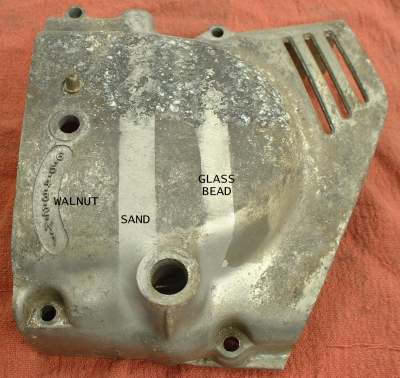
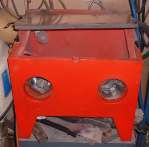 Once you decide on what type of blasting media to use you will need to decide on exactly how you want to blast the part. This can be simple or very complex. The easiest way is simply to buy a blasting cabinet. They come in all kinds of sizes and shapes depending on how big the objects you want to blast are. Prices start at about $100 and go up to thousands of dollars. You can make a cabinet too.
Once you decide on what type of blasting media to use you will need to decide on exactly how you want to blast the part. This can be simple or very complex. The easiest way is simply to buy a blasting cabinet. They come in all kinds of sizes and shapes depending on how big the objects you want to blast are. Prices start at about $100 and go up to thousands of dollars. You can make a cabinet too.
You don't have to have a cabinet but it sure helps if you do have one. You can just buy a portable gun and media hopper kit and have at it. This works but has two distinct disadvantages. One, it's wasteful and two it's down right messy. The blast media is reusable. Yes, it does wear out with use. However, unless you are working on a special project that needs a very uniform finish, you can reuse it many times. As to messy. This stuff goes everywhere. If it is contained in a blasting cabinet you will not be getting it in your mouth, down your back, in your ears, well, you get the picture.
If you have a part that is just too big for a Blast Cabinet (like a motorcycle frame) you can use a portable gun like the one above and then build a big tent out of 1x2 or 2x4 wood, plastic tarps and duct tape. Then blast away! When the media hopper is empty simply sweep up the spent media on the floor and put it back into the hopper. Build the tent big enough and you could blast a car body.
A word on safety here. If you use a blast tent or just blast out in the open you need a good respirator and good eye protection. Think about it. The blast media does degrade as you use it. Breathing glass dust or sand dust will not do your lungs or your eyes any good.



 |
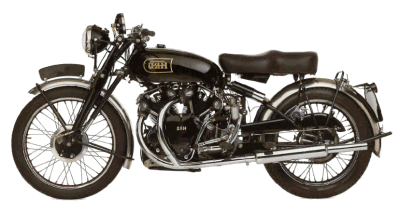 |
Copyright © 1999-2008 dansmc.com. All rights reserved.
